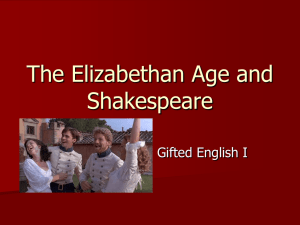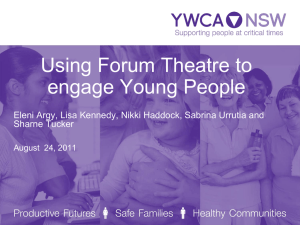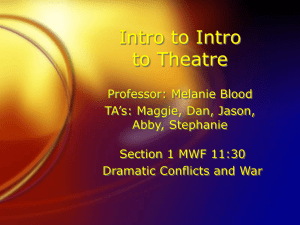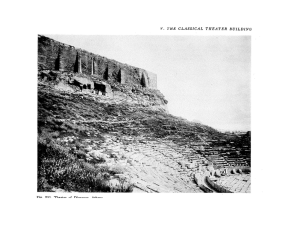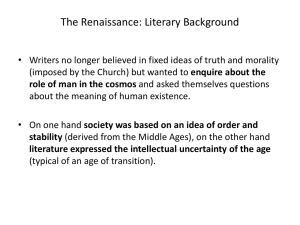File - Mrs. Henry`s English Class
advertisement
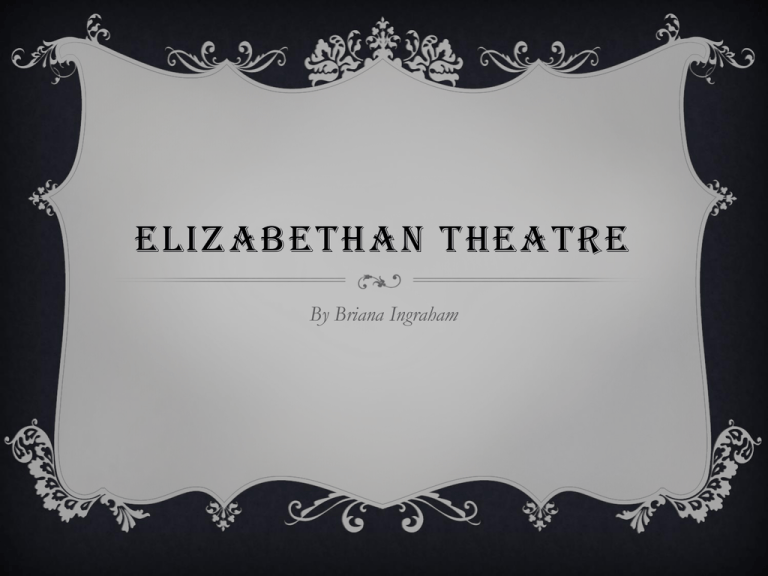
ELIZABETHAN THEATRE By Briana Ingraham WHEN - TIMELINE Started in the late 1500’s and ended in the middle 1600’s. * 1562 – Gorbodrc blank verse tragedy * 1567 - First commercial play house * 1580 – Tried to shut down all theatre’s in city, but due to Queen’s love of Drama, they were only shut down in epidemics. * 1642 – Shut down all theatre’s, then reopened in 1660, but best time already gone. WHEN - SEASONS At the start – * Winter & Spring – Preformed in London (Homes, courtyards, etc.) * Summer & Fall – Went through neglected roads on the English Countryside playing in taverns for rooms. WHERE DID THY ACT? Other places were Mainly played in Inn – yards, Amphitheaters and theatres built town squares/ residences and outside of the city. taverns. * Built like Roman arena’s for the * Mainly horseback travel and played on cobble stone yards. * Played for nobles or royals in their homes on request. light, room, and appeal to Roman and Greek style plays. * EX: The Curtain, The Globe, The Rose, The Swan, and The Fortune WHAT TYPE OF CHARACTERISTICS? The major characteristics of this time period consists of: - Art, Drama, Poetry, Literature, Poetry, Music, and Her Royal Majesty the QUEEN! During this time, the Queens image and actions influenced every part of English culture including a lot of Drama and music. The Queen attended many plays and soon all boy schools incorporated drama into their curriculums. Fashion, image, music, and more all came from what the Queen did. WHAT ABOUT THE PLAY? Playwrights consisted of middle class men and the bohemian society: * William Shakespeare, Christopher Marlowe, Robert Greche, John Lyly, Thomas Lodge, Robert Johnson…. * Wrote about the Queen, Nobles, Court Tragedies, Heroes, Comedies, etc. Often directed their own plays and acted in them. Everyone participated in setting up the set, the technical aspects, and props, but playwrights had overall pick for what happens and where. http://www.youtube.com/watch?v=lF4NJrxu5Xo - Quick review WHAT ABOUT PERFORMERS? Men Actors - Costumes Men were mainly the only actors during the time. Younger boys played the roles of women. * Costumes: Dressed in Nobel, Royal wear. Bright colors with tons of orientation from feathers to beads. Made of velvet, furs, silks, lace, cottons, or taffeta Women Actors - Costumes Women were not fully accepted into acting until 1660. * Costumes: Also, dressed in Nobel, and Royal wear. Bright colors with trims and fabrics the same as men. They had extra attachments with bodice and skirts that were big and flashy. (Men’s often more fantsy) Girls Clothing (First minute and a half = underclothes. The rest is over top.) http://www.youtube.com/watch?v=j2bpZL2JHPE AND THE STAGE? Set: * Made to look like their scenes usually had props to change the idea of scene to scene. Included false ceiling and trap doors. Props: * Included ropes, wires, and harnesses for flying. Also, flowers and flower petals. Music, live animals, blood, intestines, and bones from dead animals. STAGE - CONTINUED Sound: * Cannons were used for battlefields as well as fireworks. Thunder created from rolling a cannon ball. Actors made false sounds they practiced for ‘Hell’. Musical instruments played a large role in text painting. Music: * Mostly orchestra, above stage, instruments like cymbals and trumpets. They were used to act out scenes and give importance. Or sound effects mostly. WHO ARE THEY? Performers: (Main) * Henry Condell, Richard Burbage, John Hemmings, William Shakespeare, Edward Alley…. Writers/Directors: * William Shakespeare, Christopher Marlowe, Robert Greche, John Lyly, Thomas Lodge, Robert Johnson…. Associated Directly/Indirectly: * Queen Elizabeth, Shakespeare, Robert Johnson, Nobles, Courts WHO WATCHED THE PLAYS? Poor/Lower Class – Open pit on the floor where they could stand. It was crowded and gross. Middle/Upper Class/ Aristocrats – Three rows of box seats circling the stage WHY DID THEATRE END UP WHERE IT DID? Theater evolved during this time due to the amount of time spent trying to make it better. Also the Queen’s love for it influenced the rising of playwrights and theatre for her. After it was considers a catharsis to most people in the lower caste. The performances were created to express the Queen, Nobel's, Courts, Hero's, Tragedies, that people loves and found a way to know what was happening. WHY - CONTINUED Costumes were created this way because every color represented a different feeling, character, scene, and idea that was to be set across. Theatre was used as a fashion show to the lower class because they normally don’t get to see these types of clothing. Theatre like Elizabethan theatre wasn’t seen for awhile after this era due to the new king’s reign and his shut down of the theatres. After they reopened, the spark had gone and people had moved on. Theatre evolved from the Queen’s love and the Renaissance and the performance evolved from competition. WORKS CITED Alchin, Linda. Globe Theatre Special Effects. SiteSeen Ltd, June 2014. 27 August, 2014. <www. bargstage.org> Alchin, Linda. Elizabethan Actors. Siteseen Ltd, 2014. 27 August, 2014. <www.elizabethan-era.org> <www.google.com> Hogman, Charlotte. Elizabethan Drama. Immediate Media Company, 2011. 27 August, 2014. <www.historyextra.com> Trumbull, Eric. W. Trumbull, Eric. Dr. The Elizabethan Theatre. Eric W. Trumbull, 2007. 27 August, 2014. <novaonline.nvcc.edu> WORKS CITED CONTINUED Elizabethan Theatre. National Endowment for the Arts and Arts Midwest. 27 August, 2014. <www.shakespeareinamericancommunities.org> (No Name). Queen Elizabeth I Elizabethan Literature. SparkNotes LLC, 2014. 27 August, 2014. <www.sparknotes.com> Brown, Starla and Nelson, Chequita. Costumes and Sets in Shakespeare's Theatre. (No Publisher Seen), (No Date). 27 August, 2014. <www2.springfeild.k12.il.us> www.william-shakespeare.info ( No information given) <http://www.youtube.com/watch?v=iWdKmOeUmXg> – Over Set
